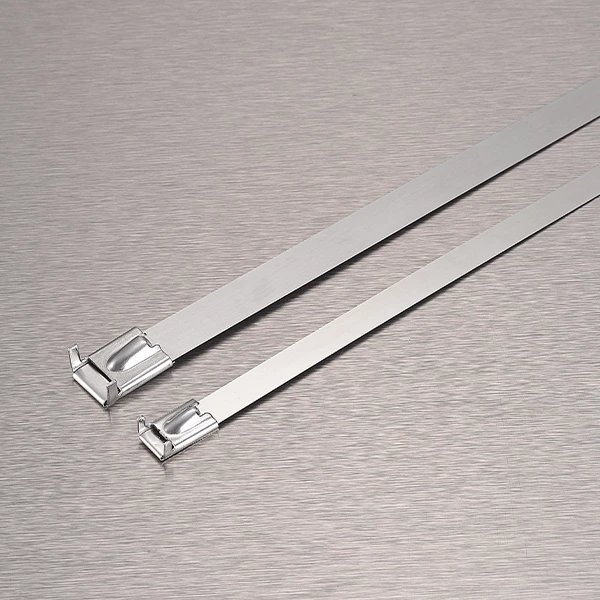Stainless Steel Cable Ties Usage Guide: Industrial Fixing And Bundling Solution
ss cable tie sizes are a high-strength, corrosion-resistant fastening tool widely used across various industries, including electrical, construction, chemical, and marine engineering. Compared to traditional plastic cable ties, stainless steel cable ties provide higher tensile strength and a longer service life, especially in extreme environments. This article will explain the usage of stainless steel cable ties, including the correct operational steps, application fields, and important considerations to help users improve work efficiency and ensure the safe operation of equipment.
1. Basic Introduction to Stainless Steel Cable Ties
As the name suggests, steel cable wrap are made from stainless steel, offering excellent corrosion resistance and tensile strength. Common materials used in stainless steel cable ties include 304 and 316 stainless steel. 304 stainless steel cable ties are widely used in most industrial environments, while 316 stainless steel cable ties are commonly used in marine environments or chemical industries due to their superior resistance to saltwater and chemical corrosion.
Stainless steel cable ties are widely used for securing cables, wires, and pipes, especially in wind power generation, petrochemical, and electrical equipment industries.
2. Main Features of Stainless Steel Cable Ties
Corrosion Resistance: 9mm steel cable provide exceptional resistance to corrosion, capable of withstanding acid, alkali, saltwater, and damp environments.
High Strength: Due to their material properties, stainless steel cable ties offer much higher tensile strength than ordinary plastic ties, making them ideal for heavy-duty applications.
High-Temperature Resistance: Stainless steel cable ties can endure extreme high and low temperatures, making them suitable for tropical and cold environments.
Long Service Life: Thanks to their corrosion and wear resistance, stainless steel cable ties last far longer than plastic cable ties, reducing replacement and maintenance costs.
Adjustability: Stainless steel cable ties feature a unique locking mechanism that securely fixes objects of varying sizes and shapes.
3. Correct Usage Method of Stainless Steel Cable Ties
Choose the Right Stainless Steel Cable Tie Model
Before using cable tie ss316, it is crucial to choose the correct model based on the working environment, the weight of the object to be fixed, and the size of the fastening object. Different models of stainless steel cable ties offer varying tensile strengths, lengths, and widths. Common sizes include:
Widths: 4mm, 6mm, 9mm, 12mm;
Lengths: 300mm, 500mm, 800mm, 1500mm;
Tensile strengths: ranging from 200kg to 1000kg.
For example, if you need to secure pipes in a highly corrosive environment, it is recommended to use 316 stainless steel cable ties. In less demanding industrial environments, 304 stainless steel cable ties will suffice.
Prepare the Necessary Tools
Although stainless steel cable ties are extremely strong, some tools are needed to help with bundling and tightening. Common tools include:
Cable tie tightening tool: Used to ensure that the tie is securely fastened and to cut off any excess tie material.
Scissors or wire cutters: After tightening the tie, scissors or special cutting tools should be used to remove any excess tie material for a clean finish.
Gloves: Wear gloves during operation to avoid injury from sharp edges, especially for prolonged handling.
Usage Steps
The steps for using stainless steel cable ties are simple, but each step must be performed accurately to ensure the durability of the fix. Here are the standard steps:
Step 1: Choose the appropriate size of stainless steel cable tie, ensuring that the width and length are adequate for the securing task.
Step 2: Wrap the stainless steel cable tie around the object to be fixed (such as a pipe, cable, or equipment), ensuring the two ends overlap. The tie should fit evenly around the object, avoiding being too tight or too loose.
Step 3: Insert the tail end of the tie into the locking mechanism and use a specialized tool to tighten the tie, ensuring that the object is securely fixed.
Step 4: Use wire cutters or specialized scissors to cut off the excess part of the tie. Be sure to leave a small distance from the locking part to avoid loosening the tie.
Step 5: Check the fix to ensure the tie is securely holding the object and that there is no movement. If the fixed object is heavy, consider using multiple ties for reinforcement.
Adjustment and Inspection
After the tie is installed, it is essential to check the stability of the fixed object. For heavy-duty or high-temperature applications, regular inspections should be conducted to ensure that the tie has not suffered fatigue, breakage, or loosening.
4. Real-World Application Cases of Stainless Steel Cable Ties
Case 1: Electrical Industry
In the electrical industry, coated cable ties are widely used for securing cables and pipes. For example, during the cable fastening process in a large power plant, operators used 304 stainless steel cable ties to secure high-voltage cables. Thanks to the high tensile strength of the ties, the cables were able to perform reliably in high-temperature and humid environments. After years of use, the cable ties showed no signs of loosening or corrosion, ensuring the safe operation of the electrical equipment.
Case 2: Chemical Industry
In chemical plants, due to the corrosive nature of chemicals, traditional plastic cable ties often fail to withstand long-term use. Therefore, many chemical plants opt for 316 stainless steel cable ties, which offer superior corrosion and high-temperature resistance, making them ideal for chemical environments. For instance, a chemical company used 316 stainless steel cable ties to secure chemical pipes, and after prolonged use, the pipes remained securely fastened without any loosening or corrosion, ensuring the normal operation of the factory.
5. Precautions and Common Issues
Proper Tensioning: Tying the cable tie too tightly or too loosely will affect the effectiveness of the fix. Adjust the tension based on the object's characteristics.
Avoid Sharp Edges: The cutting edges of stainless steel cable ties are extremely sharp, so be cautious when handling them. Always wear gloves to prevent injury.
Regular Inspections: For objects in high-temperature or corrosive environments, regular inspections should be conducted to ensure the ties remain stable and functional over time.
6. Conclusion
fire rated stainless steel cable ties are a highly effective fastening tool with a wide range of industrial applications. By following the correct usage methods, these ties can ensure the stability of equipment and pipes in extreme environments, reducing maintenance and replacement costs. Choosing the appropriate model, applying the correct usage methods, and conducting regular inspections and maintenance are key to ensuring that the ties perform reliably over time. In industries such as electrical, chemical, and marine, stainless steel cable ties, with their high strength, corrosion resistance, and high-temperature resistance, have become an indispensable industrial fastening solution.
FAQs
Q1.What are stainless steel cable ties made of?
A1.Stainless steel cable ties are typically made from 304 or 316 stainless steel, offering high corrosion resistance and strength.
Q2.How do I choose the right size of stainless steel cable tie?
A2.Choose based on the object’s size, weight, and environment; common widths range from 4mm to 12mm, with lengths from 300mm to 1500mm.
Q3.Can stainless steel cable ties be used in high-temperature environments?
A3.Yes, stainless steel cable ties can withstand extreme temperatures, with a range from -40°C to +600°C.
Q4.How do I properly tighten a stainless steel cable tie?
A4.Insert the tie into the locking mechanism, tighten it using a specialized tool, and trim any excess length with wire cutters.
Q5.Are stainless steel cable ties reusable?
A5.No, stainless steel cable ties are designed for single use and should be replaced if removed.



